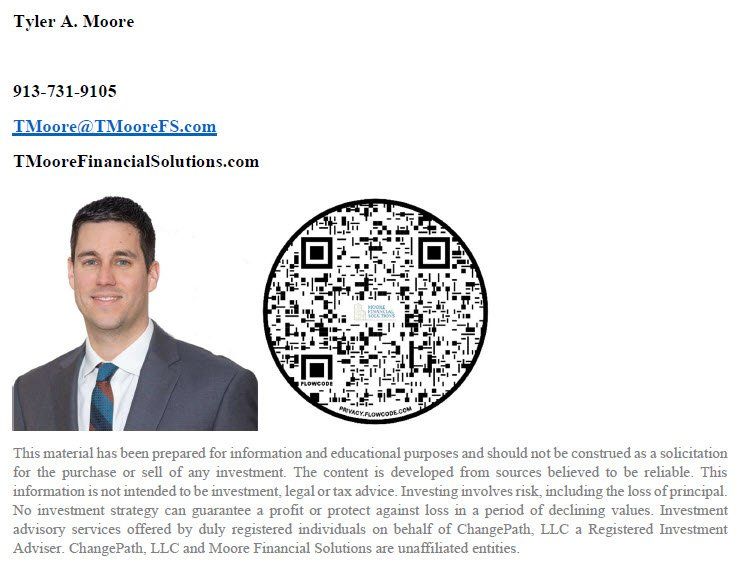The second quarter of 2022 reminded investors that volatility remains a function of long-term investing, as the broad stock market attempted to identify if the United States is headed into recession. As the S&P 500 posted another losing quarter, falling 16.45%, the market seemed to be pricing in a recession (1). The Federal Reserve moved interest rates higher to ease inflation while not showing much remorse for how financial markets were impacted. The Federal Reserve appears to be willing to slow the economy to avoid long term detrimental inflation. This Moore Financial Solutions quarterly review will detail the Federal Reserve’s actions, interest rate function/strategy, and how we aim to navigate the uncertainty moving forward. As I personally receive feedback from clients and aim to adjust to their needs, I am specifically tailoring this review to be more understandable to the client who holds less knowledge of financial markets/investment management.
By the time you reached high school, you likely learned that your life will be most comfortable when you set a budget and stick to it. You may budget $500 per month for your family to spend at the grocery store, and for years that number worked. Suddenly, that same $500 no longer allows you to enjoy the quality of foods you’ve grown used to. As you plan meals prior to going to the store you find it hard to determine which recipes include a good balance of nutrients and cost because prices are changing so rapidly. In addition, some items have increased in cost much more rapidly than alternatives, leaving you less confident in which to select. Comparatively, companies are making many of the same tough decisions, with little clarity on which direction prices are heading. These small choices that families are presented with, draw comparison to massive multimillion dollar long-term decisions corporations are making. These characteristics lead to uncertainty within both your family and corporations. You may ask, “why do I care about corporations, I hear their greed is the problem”? The answer is simple: You own the corporations! You own them in your accounts managed by Moore F.S., through your 401k, etc.
Clearly, when prices are increasing, this makes it tough for both large corporations and everyday families. Additionally, price instability is a huge concern and makes financial planning very challenging. We plan to detail how price instability occurs and the potential course of action to mitigate it.
Covid-19 sent shock waves through the system and created an imbalance to many individuals. Those in the service/hospitality industry were struggling to make ends meet, while those in the I.T. industry were saving money working from home. As it was difficult to determine quickly who needed help the most, direct payments went out to most Americans. These direct payments were a life support to some, while simply adding to the savings accounts of those who needed the payments less. In addition, an estimated
$2 Trillion in emergency aid was provided through the C.A.R.E.S. act and other emergency stimulus (2). As this emergency package of money seemed to be air-dropped into Americans’ laps, they continued to build their savings and pay down debt, a common strategy during times of fear/uncertainty. Months down the road the consumer strengthened, and Covid-19 appeared to be another challenge that we as Americans could overcome. Vaccines came out, Americans became confident in their natural immunities post-infection, and antivirals were released. Suddenly people felt like they got their groove back. As the now healthy consumer bounced back from living under their rock, they felt comfortable spending again, and with interest rates at near record lows, they were able to stretch their dollar when they elected to finance larger purchases. This large amount of money, competing for a limited amount of goods, quickly led to inflation. Inflation increased further with record gas prices and increased labor costs, as many pushed for a higher minimum wage. A higher minimum wage generally moves the majority of wages higher. Inflation is like a natural gas leak in your home, it needs fixed immediately to not lead to a much worse explosion (within the economy). Suddenly, a Federal Reserve that approximately 15 years ago was decreasing interest rates to put the economy on a steroid, is tasked with increasing interest rates. In addition to increasing rates to slow the economy, the Federal Reserve is reducing their balance sheet.
This effectively pulls money out of the economy, leading to less overall supply of money within the economy. The Federal Reserve can sell treasuries and similar units to pull money out of the economy. As monetary policy becomes more restrictive, individuals and corporations become more selective on where money is spent. This short-term (hopefully) slowing of the economy allows prices to stabilize.
Jerome Powell, the Federal Reserve Chair, has voiced a commitment to do whatever it takes to control inflation and has said the bigger risk is to fail to restore price stability (3). As interest rates rise and monetary policy becomes more restrictive, the stock market is taking a step back with the S&P 500’s first 6 months of 2022 returning negative 20.58% prior to dividends (4). The last 3 years the S&P 500 has returned 31.49%, 18.40% and 28.71 respectively, for years 2019-2021 (5).
Most clients want to know, “when will the pain end and what will make it end?” This answer is complex and regarded as difficult to answer, in our opinion. We remain optimistic that Jerome Powell is transparent and committed to his goal to do whatever it takes to beat inflation (6). This is far from an immediate win for the economy though, given his main tool to fight inflation is tighter monetary policy, which may involve a slowing of the economy. We feel additional optimism is drawn from the Federal Reserve being aggressive in the recent .75% interest rate increases, as opposed to a .25% increase, for example. We believe the Federal Reserve is having to be so aggressive because they were late to begin increasing rates, as they admit to some degree, they got it wrong that inflation was not just transitory (7). It is hard to determine when the pain of this bear market will end, as it seems to hinge on whether the United States will go into a recession, which hinges on if the Federal Reserve will tighten monetary policy enough to tamp down inflation without overshooting and sending the economy into unnecessary downturn. A recent Forbes article suggests bear markets historically last 449 days when they precede a recession, compared to 198 when a recession does not occur (8). In our opinion, if inflation readings can begin to show that Federal Reserve policy is having the desired effect, markets will begin to recover. Moreover, a Jerome Powell win regarding the velocity and trajectory of interest rate changes may keep the economy out of recession.
We understand that market volatility naturally creates discomfort and concern. It serves as a reminder that the stock market is not a money tree, and one must maintain an understanding of volatility at times. In 2022, we aim to implement strategy regarding conversions from IRAs to Roth IRAs for clients in which it is appropriate. Additionally, we are enacting a reallocation strategy from bonds to stocks, when appropriate. Contributing during lower markets remains a key priority to getting what you deserve once stock markets recover. We see current market contributions like piers driven the deepest in the construction of a bridge. While these piers take the most effort, they in turn bear the most weight. Comparatively, it may seem difficult to continue to contribute now but these contributions stand to make the most progress once markets recover.
I continue to manage each account individually and strive to put the upmost strategy and effort into getting you what you deserve. This month marks my 10th year in the industry, and I want to thank you for being a valued client of my firm. Whether I’ve been working with you for 10 years or 10 days, my goal is to make your investment experience comfortable in all market conditions. Some years my best influence on your money may be to lose less than the broad market by remaining diversified and not blindly following risks. As we are halfway through this year, only time will tell how it will end up. I’m proud to say that while some investment firms are trying to find a reason to put you into a new product, my goal is to always act in your best interests. It is with great pride to act as your fiduciary and navigate challenges together.




